#Water Spinach Cooking
Text

Kangkong (Water Spinach) with Bacon
I was thrilled to see this at the Asian grocery and promptly grabbed it because I was craving a healthy supper choice. This green veggie was a staple of my childhood. In our backyard, my father planted this particular veggie. Cooking oil, garlic, onions, vinegar, and soy sauce are used to sauté it. This is a fantastic main course or side dish. It's a terrific vegetarian recipe even without the bacon, but I decided to add some. A tasty, fresh dish that fulfilled my need.
"Anyone who's a chef, who loves food, ultimately knows that all that matters is: 'Is it good? Does it give pleasure?'" ― Anthony Bourdain
#food#asian cuisine#filipino cuisine#pinoy food#kangkong#water spinach#vegetarian dish#homemade#home cooking#home cooked meal#healthy food#healthy eating#healthy cooking#my photography#food photography#original photography#thelcsdaily
146 notes
·
View notes
Text
*through gritted teeth* hey! i wanna get better!
#dragging myself thru the mechanisms of care . fingernails clawing deep#tonight i will have enough spinach sun dried tomato pasta salad to last the full week. w/o cooking again#i will get in the shower soon. i am drinking water.#tomorrow if im better abt eating and drinking water i- oh wait i have after work plans.#THURSDAY. if im better abt eating and drinking water. i will go for a one mile run.#i am going to have fresh fruit and tomatoes w pasta for dinner. and then ice cream.#and then i am going to read one chapter of a book. just one chapter! that's all im holding myself to!!!#ah shit i was supposed to do laundry. ok. this is fixable.#im going to do laundry.#we CAN conquer the scaries the executive dysfunction (how tf do u spell that.) the bad brain days. we CAN.
8 notes
·
View notes
Text
if food is that what i want, water is that what i'll get.
#bitch ur not hungry#drink#WATER#just water for me please#okay but i wanna eat my vegetables so badly#food? no thanks ill pass hahha#water >>> food#i cooked spinach beans broccoli cauliflower and it looked good#but im kinda hungry too#tips#@na tips#weight loss tips#@n@ tips#anorexcya#an0rec1a#ana bllog#ana trigger#tw restriction#tw restrictive ed#restrictive diet#omad
4 notes
·
View notes
Text
Stir-fried Ensai (cooking)
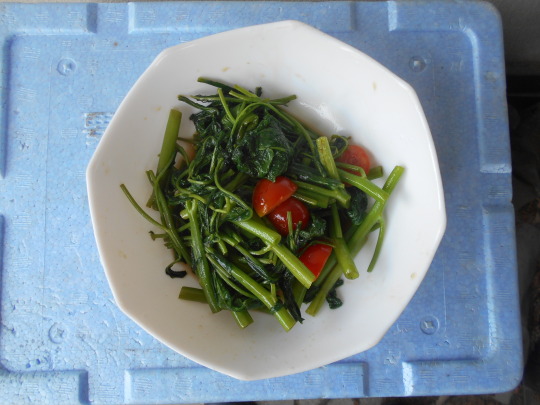

Ensai
Ensai is a vegetable of the Convolvulaceae family and is closely related to sweet potato. Potatoes can't grow, so they eat stems and leaves. Product of South China. There are many other names, and it is also called Entsuai, Yotsuai, Morning Glory Vegetable, Water Spinach, etc. It is delicious to heat and eat, especially stir-fried, but the drawback is that it quickly turns black after heating. It must be delicious.
エンサイの炒め物(料理)
エンサイは、ヒルガオ科の野菜で、サツマイモに近縁。芋はできず、茎葉を食べる。中国南部原産。別名が多く、エンツァイ、ヨウツアイ、アサガオ菜、空芯菜などとも呼ばれる。加熱して食べる、特に炒めるのが美味しいが、加熱後、急速に色が黒くなるのが難点。美味しいのには違いない。
(2023.08.19)
3 notes
·
View notes
Text
why the fuck is spinach so watery.
1 note
·
View note
Video
youtube
VILLAGE FOOD A simple but Very Yummy Recipe Water Spinach Curry Kalmi Sh...
#water spinach recipe#village food#deshi food channel#cooking#easy recipe#delicious recipe#simple recipe
0 notes
Text
siracha mayo canned salmon over rice my best friend my guiding light my lover i kiss on the mouth with tongue
#barking tag#its So good.#put some spinach in there and some bok choy cuz i needed to get rid of em and it was Better than usual.#esp considering i know the ratio of water to rice i need to use to cook it now#ultimate food. whipped that shit up in like 20 minutes. god loves me
0 notes
Photo

Spinach Pie
This yummy breakfast pie looks like a quiche but only takes minutes to make.
0 notes
Text
meal ideas!
low energy ("do not ask me to do any prep work at all, so help me god")
mozzerella cheese wrapped in pepperoni ("pizza tacos"!)
hummus and pretzels or naan (putting the naan in the microwave for like 10 seconds...heavenly)
canned chili (with shredded cheese and sour cream if you have it! boom done!)
instant miso soup (warm and lovely! put tofu in it for protein!)
cheese and cured meat, olives, canned fish, crackers, dried fruit, or whatever easy "charcuterie" type items you like
alternate bites of apple and spoonfulls of peanut butter (mixing honey or chocolate chips to the peanut butter is my favorite)
a "deconstructed sandwich": bites of lunch meat, pickles, cheese, cherry tomato, etc (I love roast beef and white cheddar for this)
yogurt and granola or fruit
put frozen potstickers + frozen edamame in the steamer/rice cooker, chill elsewhere with a timer set, then boom
tortilla chips + canned refried beans + cherry tomatoes + cilantro + jarred salsa con queso (or warm shredded cheese on top of the chips in the microwave for 30 seconds)
bagel + cream cheese + lox
microwave scrambled eggs (add things like green onion, soy sauce, or anything else you like!)
cottage cheese and fruit (mixed together or just on the side)
bowl of shredded rotisserie chicken + buffalo sauce + a bit of mayo + green onion (use a kitchen scissors to cut them right in!)
medium energy ("I'll boil water but don't ask me to chop shit")
boiled eggs and fresh veggies (put a little salt on top of the eggs!)
buttered noodles (my go-to nausea meal, it has never failed me. ideas of things to add: frozen peas, imitation crab, roasted garlic)
baked potato with toppings (I like cheese, bacon, broccoli, green onion, and sour cream)
quesadilla (add some canned beans, cilantro, or avocado!)
pot roast (requires a lot of time but not a lot of actual work. I love it with peas!)
cuban sandwich (bread, swiss, pickle, mustard, ham... my favorite thing to panini-ify by far)
pan-fried tofu with scallion sauce (this sauce goes well with everything and tofu is no exception)
pancakes or waffles! (I love mine with jam)
ham, pickle, and cream cheese roll-ups
fried eggs (with toast and lots of butter...so comforting)
fruit smoothie (bananas, frozen strawberries, yogurt...or whatever!)
I hate salad but could write essays on this copycat olive garden salad (throw it in a bowl! chopping required if you use onion)
spaghetti (controversial maybe but angel hair > spaghetti noodles)
pasta salad (olives broccoli fresh mozerella... those little mini pepperonis... yeah)
stir-fried thai garlic shrimp (I like using the mini frozen salad shrimps, it's easy! use jarred minced garlic to avoid chopping!)
tuna mayo onigiri
slow cooker ribs
buffalo chicken wrap (or any number of other wrap options! shred pre-cooked rotisserie chicken to make it easier)
if your local grocery store sells pre-cooked gyro strips, that can turn into an easy wrap with store-bought pita & tzatziki with tomatoes and onions!
couscous and chickpeas
tortellini + pasta sauce + spinach
high energy ("I don't mind chopping some things up!")
stuffed shells with spinach
chicken and roasted garlic (oh my god.....one of my all time favorites)
beef tacos (I like mine with cilantro and onion, and when I'm feeling especially high energy I love a tomatillo salsa)
chicken alfredo
tom kha gai (a thai soup and my absolute favorite! you just need access to galangal)
lasagna! (freezes well and then boom! low energy meal for later)
pad thai! (not as hard as you'd think, as long as you have access to tamarind paste!)
potstickers! (this is a lovely group activity if you want to cook with housemates!)
rice and beans
bang bang shrimp (ogughfhgfuh I love it. you can also do bang bang tofu!)
minestrone soup (so many nice veggies!)
fried rice (put whatever you have on hand in there! broccoli, peas, carrot, and beef is my favorite combo)
broccoli cheddar soup
spring rolls and peanut sauce
skewers (such as beef, onion, zucchini, bell pepper... you don't need a grill, oven works!)
roasted turkey with garlic parmesean asparagus
pork chop with mashed potatoes
panang curry
chicken gnocchi soup (use store bought gnocchi or make your own if you have a high energy day!)
bibimbap (super customizable depending on what veggies you like best)
butter chicken
plus! things that have helped me meal plan:
whenever you think of a meal you'd like to make, take 3 seconds to google search it, take a screenshot of the image results, and put it in a "food ideas" folder. instant visual menu!
the concept of "meal prepping" makes me recoil but I've learned that it can simply mean preparing shredded chicken, boiled eggs, or some other simple protein that you can customize throughout the week. shredded chicken can turn into wraps, salads, pasta dishes, etc... you don't have to meal prep yourself into the same meal all week!
when I have difficulty working up an appetite, I'll scroll through my favorite restaurant menus! there might be some foods I can't make at home, but many times they're very simple to recreate because the ingredients are literally listed!
#brought to you by: i see people complaining about coming up with meals for the week#and im like..this is my favorite thing to do........let me be your meal brainstormer#additionally brought to you by: eating something is better than nothing so some of these may not be complete textbook 'meals'#but sometimes you feel like shit and just need something! so!#also this energy scale is tailored to me personally so if some categorizations dont make sense to you thats bc its about me <3#food#i might update this with dessert ideas too later. or just add to it in general
36K notes
·
View notes
Link
#food#filipino#i mean#we've been doing this for about as long as the concept of adobo has existed#but hey#i guess ypipo need the introduction#try it with kangkong#super tasty#plus the kangkong remains crunchy even after it's been cooked#so it's not like the texture will suffer#scientific name: ipomoea aquatica#but it's got a lot of english names#water spinach#river spinach#swamp cabbage (which i personally like)#water morning glory (which is a common one i see used a lot to upscale the stuff)#water convolvulus
0 notes
Text
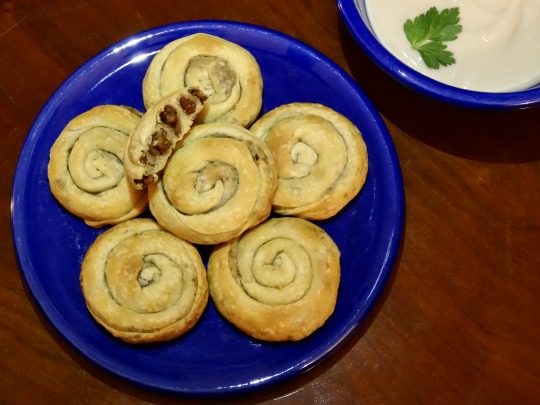
[ID: A group of pastry pinwheels on a blue plate next to a bowl of yoghurt garnished with parsley. End ID]
صفيحة يافاوية / Safiha yafawiyya (Yaffan pinwheels)
The dish
صَفِيحَة يَافَاوِيَّة ("ṣafīḥa yāfāwīyya") is a type of safiha, or flatbread, believed to have originated in the coastal city of يافا (yāfā; "Yaffa," sometimes "Jaffa"). While other versions of safiha consist of a flat piece of dough topped with meat, Yaffan safiha are made by rolling dough out to a transparent thinness, folding it to enclose a filling of meat or spinach, and then whirling it around into a pinwheel shape. More highly valued in Yaffa than flat safiha, Yaffan safiha inspires proprietary feelings amongst residents and emigrants. The technique has, however, spread to other areas in Palestine, as well as to Alexandria, Egypt, where a large number of Yaffan exiles have resettled.
Yaffan safiha may also be called "حواية" ("ḥawāya"), after a kind of towel that is stitched into a spiral and placed on top of the head to cushion it while carrying jugs of water, or trays that are hot from the oven. One Yaffan woman remembers her mother assembling these pastries at home and then bringing them, in a large copper tray, to the baker, so they could be cooked in a shared oven for a small fee. The baker's wife would have to wait to use the oven another day. The usage of communal ovens by those who do not have an oven in their home is still common practice in rural areas of Palestine.
Traditionally, the dough used to make Yaffan safiha includes only flour, salt, oil, and water. Some modern Palestinian recipes leaven the dough with baking powder; or include milk powder as a way to use food aid from NGOs, which seek to alleviate the effects of the Israeli occupation's extreme restriction of transport, travel, and agricultural activities on Palestinians' diets. With a spinach filling and without milk powder, the safa'ih may be described as "صيامي" ("ṣiyāmī): a word derived from "صِيَام" ("ṣiyām"; "fast") but which, due to the abstention from meat mandated during the Lenten fast, is colloquially used to mean "vegetarian."
Golden brown and fragrant with olive oil, these safa'ih combine layers of crisp, flaky dough with a savory, well-spiced filling. Recipes for both a 'meat' and a spinach filling are provided. A side of yoghurt and a garnish of mint round out the flavors of the filling and add tanginess and textural contrast.
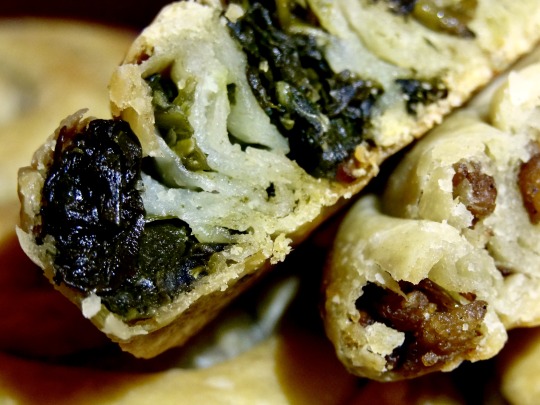
[ID: Close-up of two pinwheels cut open to reveal a spinach filling and a 'meat' filling between thin layers of pastry. End ID]
The Bride of Palestine
Yaffa is a port city with an ancient history which, until the 20th century, was the largest Arab city in, and the cultural and economic capital of, Palestine. For this reason it has sometimes been called عروس" "فلسطين ("'arūs filasṭīn"); "The Bride of Palestine." With the 1909 founding of the nearby Tel Aviv, Yaffa began to be considered its "twin" or "sister" ("האחיות") city; it had a distinctly Arab character where Tel Aviv was almost entirely Jewish. Yaffa was thus considered in disctinctly racialized terms: both attraction and threat; a source of authentic rootedness in the land which could be tapped, but also a potentially contagious bastion of Oriental "weak[ness]" ("חליש").
Yaffa had been a popular destination for culinary tourism in Mandate Palestine, with young settlers heading to the seaside to escape from religious studies and religious dietary restrictions—associated with diaspora Judaism and a lack of connection to a homeland—and to eat earthier Arab foods such as hummus, falafel, kebab, and ful.
In 1948, Zionist paramilitary organization Irgun dropped several tons of British bombs on major civilian areas of Yaffa in order to overwhelm resistance and empty the city of its Arab population; they destroyed the much of the Old City in the process. The neighborhood of المنشية (Manshiya) was destroyed shortly thereafter. Beginning in December of 1948, Yaffa was, part by part, annexed to Tel Aviv.
Today, despite the annexation and the Hebraization of the street signs, Yaffa maintains an Arab character in popular discourse. The call to prayer is heard in the streets, and the أبو العافي (Abulafia) bakery and أبو حسن (Abu Hassan) hummus restaurant and remain where they have been since the 1760s and 1970s, respectively. But increasing gentrification, rising rent prices, cafes and restaurants which cater to tourists and settlers, and the construction of Jewish-only residential projects threaten to continue the ethnic cleansing of the ancient city.
Yaffan Cuisine
Israeli occupation has tended to collapse some of the regional distinctions within Palestinian cuisine, as Palestinians are forced into exile or else crowded into Gaza and into smaller and smaller enclaves within the West Bank. Some dishes, however, still have variations that are associated with particular cities. Stuffed red carrots (محشي الجزر الأحمر; "maḥshi al-jazar al-'aḥmar"), cored and filled with rice and spiced meat, are a dish common throughout Palestine but cooked differently everywhere: in a sauce of lemon juice, pomegranate molasses, and red tahina in Gaza; in tamarind paste in Al-Quds and Ramallah; and in orange juice in the orange-rich Yaffa region. Abu Hassan restaurant serves مسبحة (msabbaha), a Yaffan classic in which chickpeas and tahina are mixed with green chili pepper, and lemon juice.
Donate to an evacuation fund
Buy an eSim for use in Gaza
Help Anera provide food in Gaza
Ingredients:
For the dough (makes 32):
500g flour (4 cups + 1 Tbsp)
1 tsp table salt
2 Tbsp olive oil
Enough water to form a soft, tacky dough (about 1 3/4 cup / 500mL)
For the meat filling (makes 16):
125g vegetarian ground beef (as a substitute for minced lamb)
1 small yellow onion, minced
1 Tbsp olive oil
1/2 tsp ground allspice
1/2 tsp ground black pepper
1/2 tsp ground cardamom
1/2 tsp table salt, or to taste
1/2 Tbsp ground sumac
1/2 Tbsp pomegranate molasses (optional)
For the spinach filling (makes 16):
500g spinach, washed and chopped
1 tsp kosher salt, for removing water
1 small yellow onion, minced
1 Tbsp olive oil
1/4 tsp ground black pepper
1/4 tsp table salt, or to taste
Squeeze of lemon juice
1 tsp shatta (hot red pepper paste)
1/2 Tbsp pomegranate molasses (optional)
Some recipes include sumac in the spinach filling, but this is not considered traditional.
Instructions:
For the dough:
1. Measure dry ingredients into a large mixing bowl. Add oil and mix briefly. Add water, a little at a time, until the dough comes together into a slightly tacky ball. Knead for five minutes, until smooth and elastic.
2. Divide dough into 16 balls of about 50g each. Roll it out into a cylinder and cut it in half repeatedly; or weigh the dough using a kitchen scale and divide by 16.
3. Pour some olive oil in a tray or baking sheet and coat each dough ball. Leave them on the tray, covered, to rest while you prepare the fillings.

For the meat filling:
1. Heat 1 Tbsp olive oil on medium-high. Add meat and fry, stirring often, until nearly cooked through.
2. Add onions, salt, and spices and fry until onion is translucent.
3. Remove from heat. Stir in sumac and pomegranate molasses. Taste and adjust. Let cool.
For the spinach filling:
1. Mix spinach with salt and let sit 10-15 minutes. Squeeze to remove excess water.
2. Heat 1 Tbsp olive oil in medium-high. Fry onion, salt, and pepper for a minute until translucent.
3. Combine all ingredients. Taste and adjust salt.
To assemble:
1. Oil a clean work surface, as well as your hands. Spread a dough ball out into a very thin, translucent circle by repeatedly patting with your fingers while pushing outwards. Be sure to push outwards from the center so that the circle does not become too thin at the edges. A few small holes are okay, since the dough will be folded and rolled in on itself.
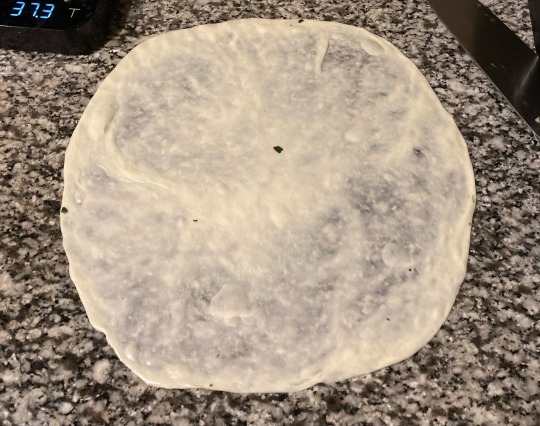
2. Cut the circle in half with a sharp knife. Spread 1/16 of either filling in a thin line along the cut edge, leaving a margin of 1 cm (1/2") or so.

3. Roll the edge of the dough (the cut edge) over to encase the filling. Continue rolling, trying as much as possible to exclude air, until you have a long rope of dough.
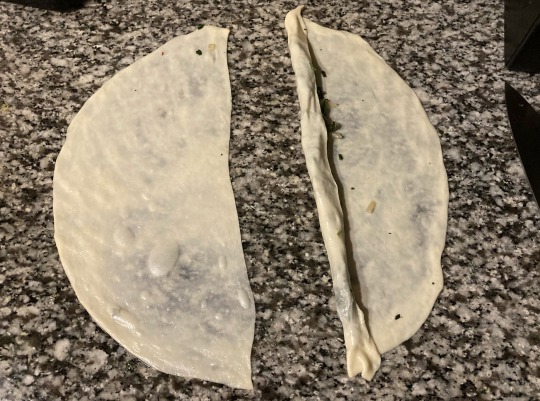
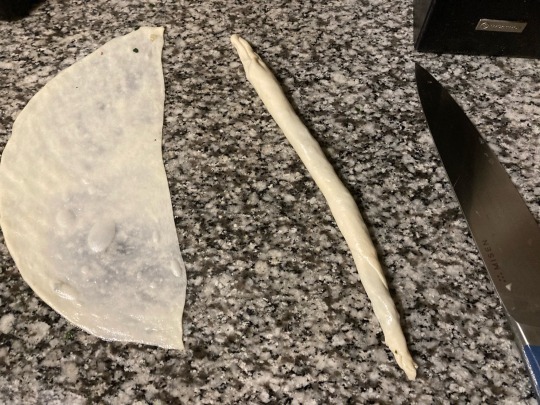
4. Roll the rope around in a tight spiral. Tuck the very end of the dough underneath and press to seal. Place on a preparing baking sheet.
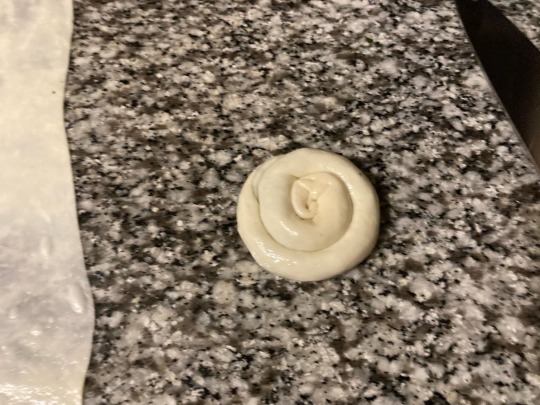
5. Repeat until the filling and dough are used up. Meanwhile, preheat an oven to 375 °F (190 °C). Bake the safiha in the top third of the oven for 25-30 minutes, or until golden in color.
Serve warm with yoghurt.
588 notes
·
View notes
Text
recipes for when you think you're about to binge (and crave something that isn't only veggies !!!!)
and its okay to eat when you need it babe <3
personally i can't live without potatoes or pasta so here are some good alternatives to please yourself !!
Potatoes and sweet potatoes (225 cals)
2 potatoes (180g)
1/2 sweet potato (75g)
peel the potatoes and cut them in little cubes (same with the sweet potato). Add spices bc they could make a boring meal a chief's kiss one!! I personally add salt, paprika, rosemary and thyme
bake for 20min at 180°C
Sweat potato nugget (recipe is for 2 parts, one is 178 cals)
1 sweet potato (150g)
bacon (40g)
honey (10g)
tomato paste (75g)
peel the potato and cut it in cubes of about 2-3cm, then roll them in the tomato paste. roll the slices of bacon around it, and use a spoon to add a little bit of honey on top
bake at 180°C for 25min
Pasta gratin (recipe is for 2 parts, 1 is 393 cals)
pasta (160g)
cream cheese light (100g)
tomatoes (150g)
cook the pasta in a pot. once they're cooked, add the cream cheese and the slices tomatoes in it and mix. you can add spices
bake in the oven for 10min at 200°C
Pizza on the stove (312cals)
tomatoes (25g)
1/2 mozzarella (62g)
1 tortilla (40g)
tomato sauce
cut the mozzarella and the tomatoes. Put the tortilla in a pan and let it on low heat (do both sides). once both sides are heated up, add the tomato sauce, the mozzarella and the tomates (I also add thyme in the sauce). cover the pan with the lid and wait until the cheese has melted (about 5-6min)
Cauliflower but better (201 cals)
cauliflower (90g)
mozzarella light (100g)
cook the cauliflower in a pot with water. add spices (salt, pepper, paprika, thyme..) once they're cooked, put them in a dish, add the mozzarella on top of it and bake for 10-15min at 180°C
Cheeseburger salad (577 cals)
minced beef (112g)
tomatoes (60g)
pickles (12g)
mustard (7g)
vinegar (4ml)
salad (56g)
mayonnaise (28g)
grated cheddar (25g)
cook the beef in a pot for 6-8min. add salt and pepper if you want. once its almost cooked, add the cheddar so it'll melt a bit
cut the salade, the tomatoes and the pickles. For the sauce, mix the vinegar, the mustard and the mayonnaise.
put everything in a bowl and mix !
chocolate smoothie (305cals)
banana (150g)
almond milk (200ml)
cocoa powder (30g)
ice
mix everything in a blender and enjoy !!
scrambled eggs (230cals)
1-2 eggs (105g)
milk (12ml)
ham (12g)
spinach (12g)
olive oil
in a bowl, mix everything together. add spices if you want, and cook in a pot until its done
zucchini pizza (278 cals)
zucchini (230g)
tomato sauce (50ml)
mozzarella (50g)
cut the zucchini in slices of about 1.5-2 cm. add the tomato sauce on it, then the mozzarella. add spices if you want, cook for 8-11 min in the oven at 200°C
I probably will add some more later !! enjoy it <3
#counting cals#tw ed but not sheeran#⭐️ve#ana meal#mealsp0#low cal meal#mealspo#ed meals#tw ed diet#ed behaviour tw#tw restrictive ed#@tw edd#ed disorder#ed not ed sheeran#tw disordered eating#tw ana trigger#thinner is better#th1nsp1ration#@nor3×14#@na trigger#@na tips#low cal restriction#low cal diet
620 notes
·
View notes
Note
do you have some favourite go-to recipes? i would love any of your recommendations!! xx
we eat the same few things on rotation in our house, as I do all the cooking, and I like a) one-pot meals, and b) pasta, preferably. most of these are fairly low effort but you get a lot of bang for your buck flavour-wise, and they're endlessly customisable!
also, listen, I don't do measurements. follow your heart and taste as you go.
the tiktok viral baked feta pasta from like 4 years ago
ingredients: plum or cherry tomatoes, a block of feta (or boursin if you're feeling flush), garlic, pasta
optional extras: spinach, cannellini beans, chili crisp
recipe: whack your tomatoes, sliced garlic, and olive oil in a big dish. nestle your feta in there. I like to add a tin of drained cannellini beans at this point to bulk it out/cut down on the pasta/make the texture confusing, but you don't have to. stick it in the oven at like 180-200C for half an hour ish. after half an hour boil your pasta. retrieve your oven dish, stir everything up to desired consistency (I'm a chunk girl). you can add spinach while you do this for extra greenery, or a massive spoonful of chili crisp for heat and crunch, but it's good on its own. add the pasta and some pasta water if you need. voila. you simply cannot go wrong.
gochujang and hummus pasta
ingredients: gochujang (this keeps forever in the fridge so it's a good kitchen investment), a tub of hummus, garlic, white onion, parm
optional extras: parsley
recipe: chop onion and garlic, sling them in a pan with butter and a splash of EVOO. when the onion is sufficiently sweaty and nice, add a dollop of gochujang (the bigger the dollop the spicier the end result) and stir it all in, followed by the whole tub of hummus. boil the pasta. add the cooked pasta to the pan, along with some pasta water, a shit load of grated parm, and garnish with parsley. my friend sent me a vegan version of this recipe about a year ago and I've made the non-vegan version roughly once a week since. it is so fucking delicious.
butter bean thing
ingredients: butter beans, garlic, red onion, tomato paste, cream/double cream/greek yog, lemon, sourdough/nice crusty bread
optional extras: parsley
recipe: throw chopped garlic and onion in a pan with butter and EVOO and really let them sweat it out. add tinned butter beans WITH THE JUICE. yes, I know. add in a few good squirty piles of tomato paste and stir, then let it all heat through. at this point start toasting your crusty bread of choice because I ALWAYS forget until the end and then I'm rushed. I recommend splurging for the good bread, slathered with melty butter. add whatever creamy thing you have to hand (the og recipe I saw said double cream, but I usually have greek yoghurt in and that does the job) to the beans, along with some lemon juice, garnish with parsley if you like and serve. use the bread as a giant spoon. you are welcome.
sausage soup/stew? casserole??
ingredients: celery, white onion, carrot, sausage/s, cherry tomatoes, tinned tomatoes, chicken broth, parm
optional extras: creamy thing of your choice, spinach, orzo
recipe: dice the celery, carrot and onion (mirepoix!), and throw it in a big big big pot with some EVOO. now: I get a pack of nice sausages and either mash or chop them depending on how much energy I have, but if you live somewhere with a butcher or whatever you can save your mashing arm and just get ground sausage. throw in the ground, mashed, or chopped sausage and cook for a bit. follow with a tin of chopped tomatoes and chicken broth. I usually put in about a litre. chop the cherry toms and toss them in. follow with a load of grated parm. if you have any parm rinds, throw em in and leave it to bubble away. this doesn't sound like much but it is so good. the longer you leave it the more flavourful it will be! towards the end I like to add in whatever creamy thing is in the fridge (double cream, greek yog, milk), along with lots of chopped spinach and a cup of orzo to really bulk it up. we can happily live on this for DAYS, especially if we have leftover fancy crusty bread from the gochujang pasta. oh and remember to take out the parm rind.
thai chicken curryish
ingredients: chicken (thigh/breast), garlic, ginger, yellow peppers, spring onion, cashew nuts, rice, coconut milk, chicken broth
optional extras: sriracha, coriander
recipe: I love this one cos it is SO quick and SOOOO easy. cut chicken into chunks and brown it in the pot. whip it back out and throw in the chopped garlic and ginger (I have a tube of ginger paste in the fridge cos WHO has the time?) with a big glug of EVOO, then a cup of rice. jasmine works, but I've also used risotto rice. toss in the chopped peppers, spring onion and cashew nuts (if I have the energy I'll chop the nuts, but you can put em in as-is), then add coconut milk (a tin's amount, be that an actual tin or some of the melted stuff that costs 1/4 of the price - thanks Asian supermarket!) and chicken broth. put the browned chicken back in, give it all a stir, cover it, and stick it in the oven for like 25ish mins. here’s the NYT recipe if you need liquid measurements/an actionable recipe that isn’t me riffing. (as always, 12ft.io/ in front of the address to bypass the paywall.) serve it with sriracha squirted all over it (HIGHLY RECOMMEND) and coriander if you like it.
delicious little rice waffle
ingredients: leftover jasmine rice, chili crisp, an egg, kewpie mayonnaise, sesame oil, spring onion, A WAFFLE MAKER
optional extras: furikake
recipe: full disclosure, you need a little waffle maker for this. mix the rice with chili crisp, a little sesame oil, and egg yolk. dollop it into the waffle maker and cook. garnish with kewpie mayo, sliced spring onion and some furikake if you have it, or just toasted sesame seeds if you have those, or neither! delicious little spicy umami snack, my beloved.
tuna melt of dreams
ingredients: you know what's in a tuna melt
recipe: swap the butter on the outside of the bread for kewpie mayonnaise and thank me later.
ADDENDUM: this goes without saying for me but sadly I know it does not for everybody: SEASON YOUR FOOD WITH SALT. IT WON'T MAKE YOUR FOOD SALTY IT WILL MAKE IT DELICIOUS. COOK YOUR PASTA IN SALT. WHEN IN DOUBT, ADD SOME SALT. THANK YOU.
#these are our staples#every so often I will come home with a bunch of new recipes and try them all and add some to rotation#Bon Appetit's dan dan pappardelle was a fixture last year cos it is SO FUCKIN TASTY but also a bit of a faff to make#SEND ME ALL YOUR EASY BREEZY ONE POT RECIPES!!!#THANKS!!!#answered#this was fun thanks
156 notes
·
View notes
Text

Fusilli Pasta Pesto Salad with Lettuce, Chopped Vegetables, Pesto Drizzle, and Burrata Cheese Ball
Ingredients:
125g fusilli pasta
1 ball of burrata cheese
100g mixed salad greens (e.g., spinach, arugula, lettuce)
100g cherry tomatoes, halved
1 small cucumber, chopped
1/2 red bell pepper, chopped
2 tablespoons pesto sauce
1 tablespoon olive oil
Salt and pepper to taste
Fresh basil leaves for garnish
Crushed red pepper flakes (optional)
Instructions:
Cook the Pasta:
Bring a large pot of salted water to a boil.
Add the fusilli pasta and cook according to the package instructions until al dente.
Drain the pasta and rinse it under cold water to stop the cooking process. Set aside.
Prepare the Vegetables:
In a large bowl, combine the mixed salad greens, cherry tomatoes, chopped cucumber, and chopped red bell pepper.
Prepare the Dressing:
In a small bowl, mix the pesto sauce with olive oil. Adjust the consistency with a little more olive oil if needed.
Assemble the Salad:
Add the cooked pasta to the bowl with the vegetables and greens.
Drizzle the pesto dressing over the pasta and vegetables.
Toss everything gently to coat evenly with the dressing.
Season with salt and pepper to taste.
Serve:
Transfer the salad to serving plates.
Place the burrata cheese ball on top of the salad.
Garnish with fresh basil leaves and crushed red pepper flakes if desired.
Drizzle a little more pesto sauce over the burrata for added flavor.
Times:
Prep Time: 15 minutes
Cooking Time: 10 minutes
#food#food blogs#delicious#recipe#food pics#homemade#foodshow#food photography#summer food#summer recipes#fresh salad#salads#salad recipes#burrata#italian#healthy eating#healthy recipe#weight loss
93 notes
·
View notes
Text
How to follow a Mediterranean Greek diet
The Mediterranean diet naturally expands throughout the coastal countries of South Europe, North Africa and the Middle East but there are some small differences between their cuisines. So here I am writing specifically about the Greek version of the Mediterranean diet, known for its delicious, natural flavours and its significant health benefits.

Eat daily:
Olive oil: the pillar, the liquid green gold of the Mediterranean Greek diet. Olive oil should be used ideally exclusively for all purposes. It's dressing salads, it's used in cooking and in fact it's traditionally what is used in frying too. Replace all types of oils, butter and margarine with olive oil even when making pastries. The only problem here is that outside of the Mediterranean basin olive oil can be pricey, however that's the foundation the diet is based on. If you are interested in following the traditional Greek diet for taste or health purposes, it is good to really incorporate olive oil in your daily cooking. If it’s not possible to afford buying olive oil all the time (although you could balance it out by not buying other oils and butter), a non-Greek-typical but equivalent alternative could be avocado oil. However, I doubt avocado oil or any other oil can remotely compare to olive oil in health properties, taste or in any other positive quality 🫒
Vinegar: Just like olive oil, vinegar is a very important ingredient and is also used in natural remedies However, it can hurt a sensitive GI tract if consumed in large portions. A little bit of it added to meals frequently is very healthy. Apple cider vinegar is also very loved and used in salads often 🍇
Vegetables: no portion can be too much (wild greens, garlic, onions, cauliflowers, cucumbers, eggplants, beets, peppers, spinach, artichokes, zucchini, peas, lettuce, the list never ends). Tomatoes and broccoli are recent additions to the Greek diet however they were integrated perfectly to the Greek cuisine. In general, all vegetables can be enjoyed freely with some moderation in the potatoes, especially when fried 🥗
Fruits: grapes, berries, apples, melons, cherries, figs, prunes, sour cherries, peaches, pomegranates are the most historically loved fruits in the Greek diet. Since the middle ages citruses like the orange, the lemon and the mandarin are more and more loved. Greeks nowadays use lemon almost more than vinegar and both have become integral components of the Greek diet. Obviously, tropical fruits like, say, banana, mango, grapefruit are not present in the traditional Greek diet, however all fruits are good fruits and you can enjoy them freely 🍎
Legumes. Eat freely to the tolerance of your body. Legumes can be too heavy for some GI tracts. Legumes are a great source of protein and fibre. Choose brown lentils, white beans, fava beans, chickpeas, giant beans and black eyed peas the most 🫘
Nuts, seeds: almonds, walnuts, sunflower seeds, peanuts etc. Eat as much as your body can take, because everybody is different 🥜
Mushrooms: mushroom it up! A great healthy way to have them is grilled with herbs and plain or apple cider vinegar dressing 🍄🟫
Whole grains: this is the traditional way to eat grains. Brown bread, oats, whole wheat pasta 🌾
Fish and seafood: find and eat them fresh. Instead of buying them deep frozen from the big markets, find local fish stores if your place is coastal and has them. Eat both large but especially small and medium sized fish. Some fish like salmon and tuna should ideally not be consumed daily due to their high levels of mercury and fats 🐟🎣🍤
Herbs and spices. Feel free to use as much as you want however if you are interested also in the flavours of the Greek diet besides the health benefits, a tip is that Greek dishes do not contain extremely hot spices 🌿
Water: A lot of water daily and, mind you, plain clear mineral water. No flavoured water, definitely not sparkling water and ideally no other liquids in place of the water. I mean, sure you can have liquids but you should ALSO have plain water 💧
Eat a few times per week:
Poultry: Poultry and lean meats entered the Greek cuisine mostly after the Middle Ages however they are nowadays enjoyed as part of the Greek Mediterranean diet because they are tasty and healthier than other types of meat. Chicken has become especially popular in the Greek cuisine. Other birds are the pheasant, the quail, the turkey and more sparsely the duck 🍗
Eggs: eggs are healthy and should be consumed a few times per week but not daily because they can cause a rise in cholesterol levels 🥚
Dairy: Greeks LOVE dairy products, especially the various types of cheese, however they are often irritating to the GI tract and they are linked with rises in the level of inflammation in the body. This is why you should ideally limit them to a few times per week. One exception is the yoghurt, which is fermented and can be perhaps consumed more frequently due to its beneficial properties. Important note: if you want to follow the Greek diet, you should ideally opt for milk and other dairy products from goats and sheep! Cow milk is not traditionally used in the Greek cuisine often and sheep and goat milk are significantly healthier and more nutritious. The only drawback is the stronger smell, however if you can get past that, it is strongly advised to switch to those instead of cow milk. Another note: what is known as “Greek yoghurt” in western countries is not in fact a true Greek yoghurt. What you call Greek yoghurt is to us simply a strained yoghurt, a yoghurt from which the whey has been removed. Sometimes in western markets (and in Greek “modern” dessert yoghurt products) butterfat and powdermilk is added to them and they are mostly made of cow’s milk. Again, a traditional Greek yoghurt is made of sheep, goat milk or a mix of both and is unstrained. It also has a trademark thickened skin on its top (dunno if this is the actual term lol) which is in fact the part of the yoghurt that contains the most nutrients and personally it’s the tastiest part of the yoghurt but apparently it is not for everyone. As an example, a study showed that an unstrained sheep yoghurt has more protein, more omega-3 fatty acids and minerals yet fewer calories and fats than a strained cow yoghurt 🍦🧀
Wine: in small portions, like a small glass up to a few times per week and always in combination with your meal. You don’t drink it to get hammered, you drink it for the health benefits it has in very moderate quantities and for the reasonable mild euphoria it causes before it becomes harmful. The GI tract is linked to the brain and is detrimentally influenced by negative emotions. This is why it is important to try to be in a good mood, relaxed and peaceful when you sit down to eat. A sip of wine now and then can be good for that 🍷
Eat once per week or ideally less:
Red meat like pork or beef. In fact, beef should be the one most avoided not only because it is indeed the rarest of the common meats used in traditional Greek cuisine but also because you can’t separate the fat from the meat as easily as with pork. To follow the Greek style in a healthy way opt for goat, then lamb or pork and make beef your most occasional meat dish 🥩
Processed meats should be eaten rarely. If you are in a mood for it though, opt for Greek style sausages with herbs in or bacon at most. Cured meats like ham are better to be avoided but turkey is the healthiest of them. They are not a part of a traditional Greek cuisine though.
Refined grains can be enjoyed weekly but should not replace whole grains
Pastries. What’s new, pastries are not ideal for health. However, if you are yearning for something sweet, if you want to keep it healthy as much as possible in the “Greek way”, opt for desserts made of healthy ingredients like honey, nuts, olive oil and fruits. Chocolate came to Greece in the 19th century, however it has become an integral part of confectionery since then. Opt ideally for dark chocolate, combined with nuts or fruits such as oranges and prunes. Greeks especially love chocolate combined with nuts.
Soft and sugary drinks. Avoid them overall, especially the processed products in the markets. If you need a sweet drink really bad, you can keep it traditional by making your own sweet lemonade, sour cherry, pomegranate etc drink at home. You could also enjoy small quantities of lemon or mastic liquors which are good for digestion.
BONUS TIPS & PHILOSOPHY:
Try to find mastic if it’s available where you live. The mastic is a resin produced from the mastic tree, a species endemic to the Greek island of Chios and a small part of the opposite coast of Turkey. It has numerous beneficial properties, especially for digestion and gut health, and it combines them with a very pleasant fresh and sweet flavour. You can find it in gums that boost digestion, in drinks, in pastries and even in non-edible products like toothpastes. Learn about it and give it a try, no matter if you are interested in following Greek diet or not.
Greek cuisine does not go berserk on as many ingredients as possible (however Greeks typically add more ingredients than, say, Italians and perhaps fewer than the Middle Easterners). Don’t worry about adding as many foods and nutrients in one single dish. The most important thing in Greek cuisine philosophy is to pick the finest ingredients. Avoid deep frozen or precooked and processed ingredients. Pick whole fruits and vegetables from your local small grocery store. For example, don’t buy a watermelon slice in a zelatin bag from the supermarket. Take the whole freaking watermelon home. You heard me right. It’s heavy, yes, but you would be surprised how much tastier and healthier it is this way. Go to the butcher for meat. Go to the specific cheese shop for cheese. Go to the fisherman for fish and seafood. Go to the pastry shop and get a nice dessert instead of buying candies from the market.
Remember that in moderation you can eat most of the foods you desire, especially if they are not processed foods. There is nothing about the Greek diet that is restrictive in terms of its philosophy - historically the intake of various foods was regulated only based on availability and price. There are no foods you should limit due to any perception of them being “bad” and you should never feel guilty the moment you are actually having the food. Just work slowly and progressively by building gradual appreciation for healthy foods and prize less nutritious foods as occasional taste bud rewards.
As said above, a good mood is crucial when you sit down to eat. In the history of the Greek society this translated into eating with friends and / or family, maybe with the occasional sip of wine, ideally in a pleasant environment and always taking your time with your food. If some of these are less feasible than others, try alternatively to improve the setting in which you eat, to eat in an environment that calms you down. Schedule your meal so that you won’t eat in anxiety or hurry, if this is possible. Think of pleasant memories and feel grateful for your food. Cheers! Or, you know, εις υγείαν!
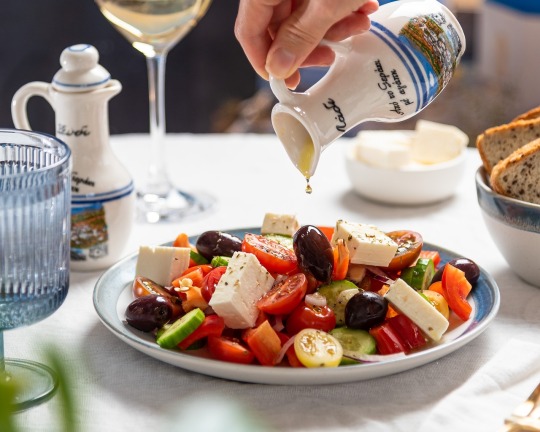
99 notes
·
View notes
Text
freshly picked mushrooms: An entire plastic trash bag's worth of them. An unfathomable amount of mushrooms. 10 litres of them, easy. We're talking 3 hours of cleaning time. Would feed five people for an entire day.
cleaned, chopped mushrooms: Okay sike, there's just enough to there be more than enough for one frying pan. Never gonna fit on that fucking frying pan btw.
cooking mushrooms: LMAO YOU FOOL. THE LOWLY SPINACH KNOWS NOTHING ABOUT THE ART OF SHRINKING. Also there's a gallon of water in here now. Whatever you were planning to fry on this pan is just gonna get boiled now. You hear me? You're getting soup for dinner. Get souped, idiot.
cooked mushroom stew: lmao double sike, this is still an unreasonable amount of mushrooms. Like four bowls of mushroom stew. Bitch you thought. Also you're still going to be hungry again like 15 minutes later.
436 notes
·
View notes